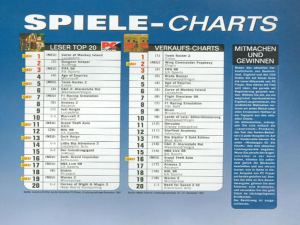While video game magazines may serve as primary sources for identifying groundbreaking titles during the rise of the CD-ROMs, charts of best-selling games reveal significant variations in data sources and formats. What are the historical issues with video game charts, and more specifically their assets ad limits? A blogpost by MAHEC student Alessio Nardecchia with the support of the CD-Hist team.
Video games played a pivotal role in making CD-ROMs widely attractive and accessible. The transition to the compact disc format in gaming accelerated in the second half of the 90s. This technological shift provided greater storage capacity, enabling richer gameplay experiences, immersive soundtracks and full-motion video.
Video game magazines may serve as primary sources for identifying groundbreaking titles during the rise and dominance of the CD-ROM format. To identify key titles, we focused on analysing charts of best-selling games in these publications. However, this task was not straightforward, as the diversity of magazines revealed significant variations in data sources and focus. Consequently, we need to acknowledge that evaluating chart inputs provided by different publications requires a critical approach. What are the takeaways from exploring video game charts, and more specifically, what are the various facets and limitations we may encounter in this process?
The following post is based on preliminary findings and initial results from an investigation into the presence and interpretation of video game charts within specialized magazine publications from the 1990s. As a side note, these magazines typically include general articles discussing the state of the gaming industry. More importantly, they feature game reviews conducted by the editorial team, accompanied by game charts that track various aspects of the gaming market. Considering the diverse range of magazines published during the 1990s, it is not surprising to find different types of video game charts.
A variety of charts
Depending on a magazine’s scope, some charts cover a single region (usually the one where the magazine is based), while others span multiple regions, offering a comparative perspective across countries. While some gaming magazines specialize in a single platform, others focus on multiple platforms. Distinguishing between gaming platforms could provide valuable insights into the heterogeneity among console players and their distinctions from PC players. This extends beyond the mere fact that certain games are exclusive to specific consoles. Furthermore, magazines evaluate games using a variety of rating scales: some employ a 100-point system, while others use smaller scales, such as 5, 10, or even 20 points. In addition to sales-based charts, magazines also featured video game rankings based on reader opinions, collected through mail-in forms included in each issue. While other types of miscellaneous charts exist, we focus on mentioning the charts most encountered charts in such publications.
A case study: PC Player
Following our brief overview of the different formats used in gaming chart presentations, we now turn to the structure of these charts, selecting the gaming charts featured in a German-based magazine called PC Player as a case study.
Specialized in PC gaming and published by Future Verlag, a subsidiary of the British company Future plc, the magazine was in circulation from 1993 until mid-2001, when it abruptly ceased publication. Being one of the first magazines we located on the Internet Archive, we selected it as an initial case study to identify key elements that illustrate the insights gaming charts and their evolution over time. We also highlight the needed precautions when using these charts in historical research. To trace their evolution, we focus on the first issue, then those featuring significant changes in the presentation of game charts.
Before moving forward, it is important to already note a research limitation: the availability of the magazines. Some may be not preserved or difficult to access. However, many popular issues have been digitized and are available on platforms like the Internet Archive. Additionally, dedicated gaming enthusiasts run websites that are committed to preserving these publications. At the same time, non-profit organizations exist like the Video Game History Foundation which focuses on archiving video game materials, including magazines, promotional content, and materials from game developers. Recently, this foundation has made its digital library accessible to the public.
The first PC Player issue, published in January 1993, featured a PC sales chart ranking titles from 1st to 15th place, starting with the most sold title in Germany. The source listed is Profisoft. There is little information available about it, it was possibly a distributor. At the time of publication, the data was already three months old, a delay that becomes apparent in subsequent issues, highlighting the time required to compile, finalize, and publish the results.
As this was the magazine’s inaugural issue, no data on reader charts was available. However, the editors anticipated readers’ participation by inviting them to submit votes for their favourite games to establish future reader-based rankings. Consequently, the first reader charts were already published one month later in the February 1993 issue.
In the following issue, the number of titles in the sales chart was reduced from 15 to 10, while the reader chart contains 15 entries. Furthermore, the reader chart was organized starting with the highest-appreciated titles, based on the in-mail responses from readers. By examining the content of both charts, they appear largely similar in terms of the game lists, with only slight differences in their order. One might infer that a correlation exists between German sales rankings and reader preferences. However, is this relationship necessarily deterministic? The reader’s chart represents only a subset of the readership, and further research is needed to assess the ratio of reader mail-ins to issue sales. This aspect will be readdressed in the subsequent comparison.
Gaming charts can also be used to analyse trends in German sales and reader appreciation. While the current ranking is indicated in the black circle, the parentheses next to the publisher’s name contain the previous position, or a “-” if the position has remained unchanged. In this example, we cannot assess this, as the first issues did not include previous data for comparison. It can be used in subsequent issues, but we found it valuable to highlight this aspect.
At this given point in January-February 1993, there is no mention of CD-ROM games, or more specifically, CD-ROM exclusive games (some older titles listed in previous charts were later republished in CD-ROM format). While this format first emerged at the end of the 1980s within the gaming industry, it remained a niche medium. Yet, it gradually gained recognition and became more widespread by the mid-1990s.
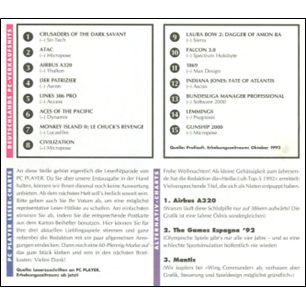
PC Player’s charts page of January 1993 which included both reader charts and sales chart among diverse rankings. Source: PC Player, Issue January 1993 (p.14, URL: https://archive.org/details/PC-Player-German-Magazine-1993-01/page/n13/mode/2up)
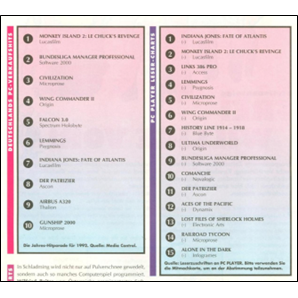
PC Player’s charts page of February 1993, which included both reader charts and sales chart among diverse rankings. Source: PC Player, Issue February 1993 (p.14, URL: https://archive.org/details/PC-Player-German-Magazine-1993-02/page/n13/mode/2up)
The beginning of the shift in media formats can be observed in this magazine. In October 1993, PC Player began distinguishing between CD-ROM and floppy disk sales, providing separate rankings for each format, both listing up to ten titles. The chart is provided by Leisuresoft, which started as an independent company specialised in game distribution in Germany. It can imply that the German gaming market was becoming increasingly exposed to the new medium during this period. The presence of both formats indicates that floppy disks remained a popular medium, while CD-ROMs were beginning to establish a parallel presence, marking a co-existence and transitional phase in game distribution. The differences between CD-ROM and floppy disk game sales are striking, as no titles appear in both rankings. However, it is important to remind that most games listed in the CD-ROM charts were not exclusive to this format. Many were also released concurrently or previously on floppy disks. In this example, only a few titles, such as The 7th Guest and Jutland, were true CD-ROM exclusives. As such, relying solely on CD-ROM sales charts to identify groundbreaking titles should be approached with caution. This is particularly true during periods when CD-ROM was neither the dominant nor the exclusive storage medium in the video game industry.
Compared to our earlier analysis of the sales and reader charts from the February 1993 issue, the rankings in the September 1993 issue differ significantly in terms of the listed games. This discrepancy may challenge the previously observed relationship and suggests that market performance does not necessarily correlate with the preferences expressed by the players who participated in the reader’s ranking.
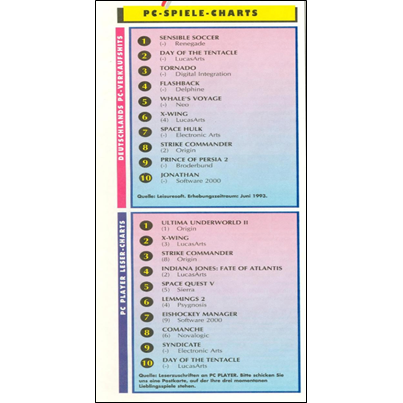
PC Player’s charts page of September 1993, which included both reader charts and sales chart among diverse rankings. Source: PC Player, Issue September 1993 (p.9), URL: https://archive.org/details/PC-Player-German-Magazine-1993-10/page/n19/mode/2up
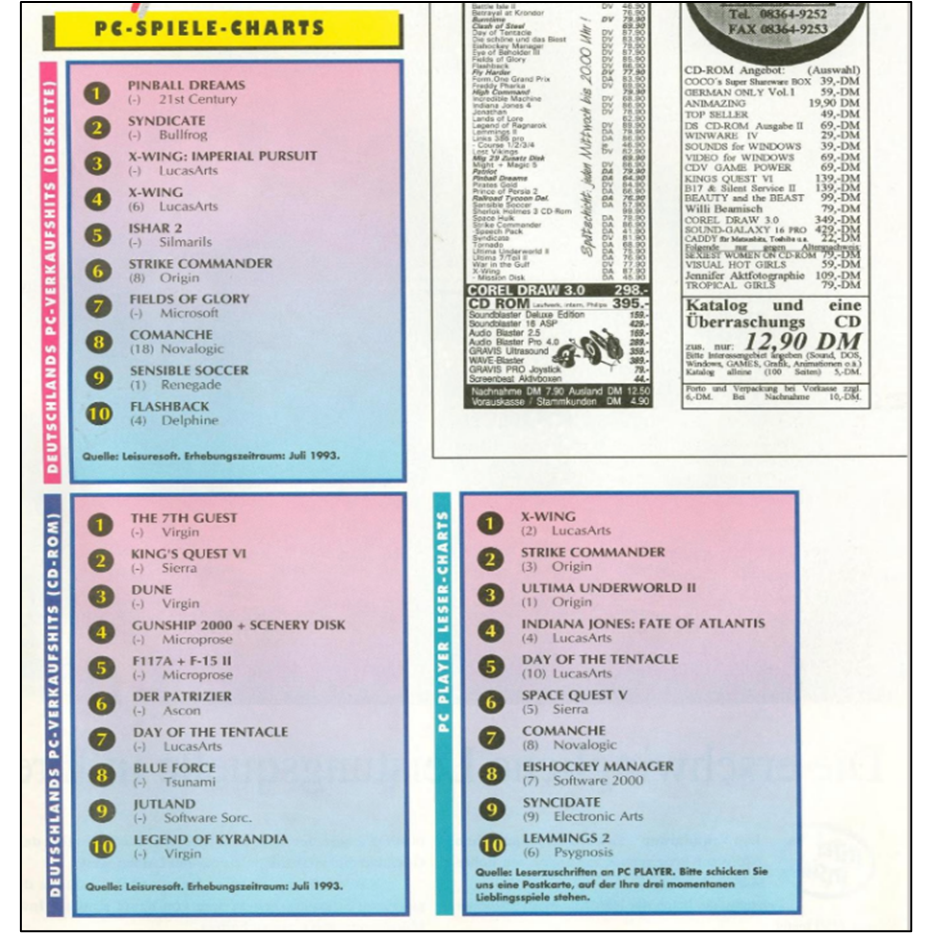
PC Player’s charts page of October 1993, which included both reader charts and sales chart among diverse rankings. The October 1993 issue introduces sales charts for CD-ROM game sales. Source: PC Player, Issue October 1993 (p.21, URL: https://archive.org/details/PC-Player-German-Magazine-1993-10/page/n19/mode/2up
The issue published in February 1996 marked the end of floppy disk sales charts in PC Player. Instead, one CD-ROM sales table is presented. Except for Bundesliga Manager Hattrick, which had earlier versions released on floppy disks, all the listed games were exclusively available in CD-ROM format. This sales chart is provided by the former German department store giant Karstadt, showcasing a different type of brand responsible for publishing sales figures. Regarding the removal of floppy disks, this may indicate a declining demand for floppy disks in the German PC market starting in the mid-1990s. The decline of floppy disk games was already foreseeable in the last issue featuring those floppy disk sales published in January 1996: 15 CD-ROM games were listed, while only 5 floppy disk games remained.
More generally, we observe a new feature in the reader’s list: it is now accompanied by the magazine’s rating for each game, based on reviews published in previous issues. These ratings, expressed as percentages out of 100, show that the reader rankings do not necessarily align with the magazine’s evaluations. This suggests a noticeable divergence between the opinions of the gaming media and those of the players.
As an additional observation, there are several entries titled “Indiziertes Spiel” in the reader’s chart . In Germany, a video game could be classified as “Indiziert” by the Federal Agency for Child and Youth Protection in the Media (BzKJ) if it contains violent content considered detrimental to the development and education of minors. Once indexed, such titles are restricted in terms of distribution, advertising, and public accessibility. This observation highlights how gaming magazine content is also shaped by German media regulation and youth protection laws.
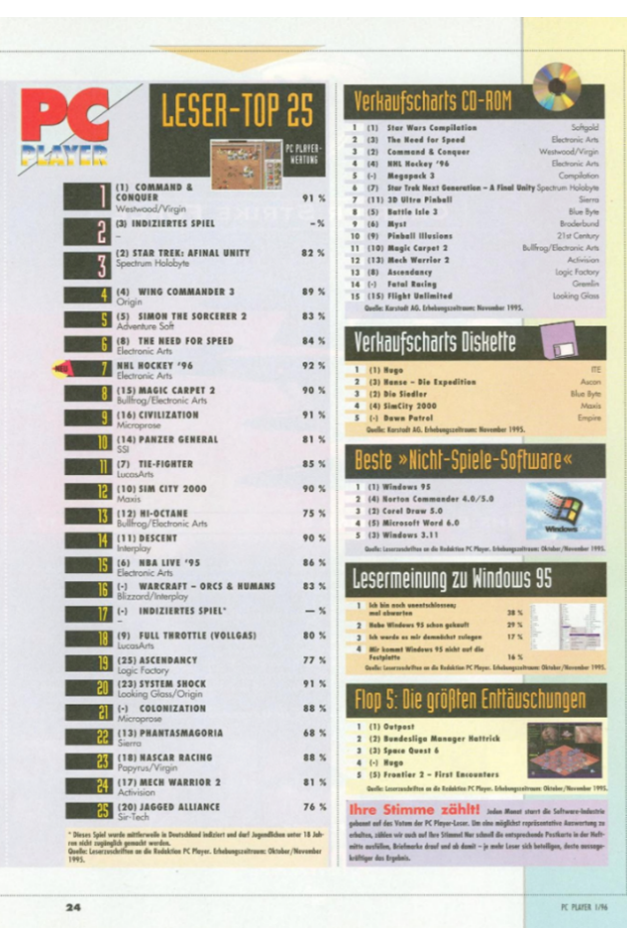
PC Player’s charts page of January 1996, which included both reader charts and sales chart among diverse rankings. Source: PC Player, Issue January 1996 (p.34, URL: https://archive.org/details/PC-Player-German-Magazine-1996-01/page/n23/mode/2up)
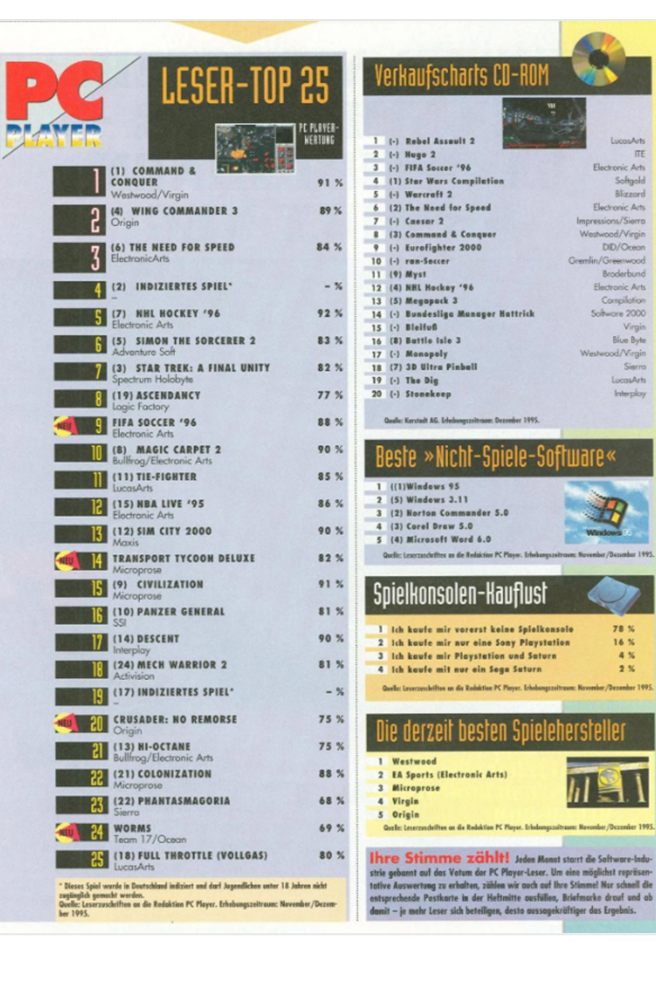
PC Player’s charts page of February 1996, which included both reader charts and sales chart among diverse rankings. Source: PC Player, Issue February 1996 (p.20, URL: https://archive.org/details/PC-Player-German-Magazine-1996-02/page/n19/mode/2up)
In the March 1998 publication of the magazine, the charts took an international turn, notably by including the charts of the American and British market, making direct comparison with other regions possible. This method of presenting video game charts provides insight into the extent of homogeneity among gamers across different regions, offering a valuable foundation for comparative analysis.
The German sales chart is provided by Media Control (now called GfK Entertainment), Germany’s official company specializing in market research and data analytics for the entertainment industry. For foreign countries, the UK charts are provided by HMV, a UK-based entertainment retailer, while the US charts were previously provided by PC Data, a market research company based in the US. PC Data was acquired by NPD Group in 2001 and has since merged into Circana. The sources for the three sales charts indicate that, at least for this month, video game chart data are mostly provided by market research companies, while British data comes from a retail company. This was also the case for Germany in January and February 1996, where sales figures were sourced from Karstadt. In the early days of the German charts, PC Player obtained its data from distribution companies such as Leisuresoft and Profisoft. This highlights the diversity of the origin of the sales numbers, ranging from distribution company to retail companies, as well as marketing agencies. What we need to take away from this is that as diversity increases, we must consider the methodologies of the companies in creating the charts. Additionally, in the case of PC Player, we need to assess to what extend they diversified their sources and when those changes took place.
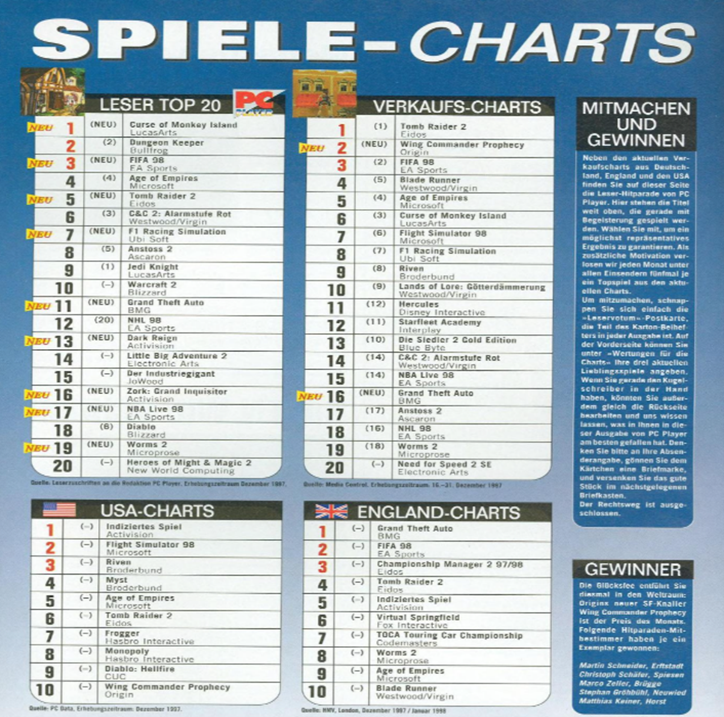
PC Player’s game charts page from the March 1998 issue, which included both German reader and sales charts, as well as American and British sales charts. Source: PC Player, Issue March 1998 (p.54, URL: https://archive.org/details/PC-Player-German-Magazine-1998-03/page/n51/mode/2up?view=theater).
Several other factors must also be considered. For instance, do these statistics consider rentals from multimedia stores or the return of unsatisfactory games? We may add practice to lend or borrow video games from relatives or friends rather than purchasing them in stores. Furthermore, the video game industry has long been affected by piracy, which has made gaming more accessible while bypassing the purchase process that would otherwise contribute to official sales figures. These three factors, rental stores, game sharing, and piracy, very likely played a role in expanding a game’s reach among the public, yet we doubt all those factors are reflected in sales data. As a result, there may be a significant gap in assessing exactly how many individuals really engaged with a given title.
Sources
- Amankwah-Amoah J., Competing technologies, competing forces: The rise and fall of the floppy disk, 1971–2010, in Technological Forecasting and Social Change (2016): https://www.sciencedirect.com/science/article/abs/pii/S0040162516000858?via%3Dihub
- Evangelho J., The Video Game History Foundation Launches Its Massive Digital Library (3/02/2025), in Forbes:https://www.forbes.com/sites/jasonevangelho/2025/02/03/the-video-game-history-foundation-launches-its-massive-digital-library/
- Harrington M. and Joshi P., NPD Venture Buys Tracking Firm (16/05/2001), in Newsday (archived): https://web.archive.org/web/20181010020752/https://www.newsday.com/business/npd-venture-buys-tracking-firm-acquisition-bolsters-li-company-s-position-in-market-data-field-1.359787
- Ihlenfeld, J., JoWooD übernimmt Vertriebsunternehmen Leisuresoft (3/05/2001), in Golem.de:https://www.golem.de/0105/13747.html
- MobyGames – Video Game Database: https://www.mobygames.com/
- PC Player (Germany) magazine issue archive (15/01/ 2013), in Archive.org:https://archive.org/details/pcplayer_germany?tab=collection
- Therrien C., The Media Snatcher, Cambridge : The MIT Press (2019).
- Video Game History Foundation digital library: https://archive.gamehistory.org/explore
- Was bedeutet Indizierung?, in Unterhaltungssoftware Selbstkontrolle: https://usk.de/die-usk/arbeit-der-usk/indizierung/
Author(s)
Alessio Nardecchia, MAHEC student.
